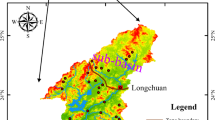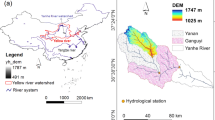Abstract
The sediment graphs (time distribution of sediment yield) are very essential if the sediment transports the pollutants that are toxic at high concentrations, requiring determination of peak, rather than average sediment flow rate. In this paper, an effort has been made to develop a simple conceptual model of sediment yield based on Soil Conservation Service Curve Number (SCS-CN) method, instantaneous unit sediment graph (IUSG) method, and Power law and the performance is tested using real field data of Chaukhutia watershed of Ramganga river catchment (area = 452.25 km2). The proposed model is found to provide realistic estimates of temporal variation of sediment yield as well as total sediment yield during a storm event. The model is found to be most sensitive to parameter β followed by k, \(\upalpha\), A, and ns. A comparison is made with the existing IUSG based models of Kumar and Rastogi (J Hydrol 95:155–163, 1987) and Raghuwanshi et al. (J Hydraul Eng ASCE 120(4):495–503, 1994) for developing sediment graphs.
Similar content being viewed by others
References
Aksoy H, Kavvas ML (2005) A review of hillslope and watershed scale erosion and sediment transport models. Catena 64:247–271
Beck MB (1987) Water quality modelling: a review of uncertainty. Water Resour Res 23(8):1393–1442
Bhunya PK, Mishra SK, Berndtsson R (2003) Simplified two-parameter Gamma distribution for derivation of synthetic unit hydrograph. J Hydrol Eng ASCE 8(4):226–230
Chen VJ, Kuo CY (1986) A study of synthetic sediment graphs for ungauged watersheds. J Hydrol 84:35–54
Chow VT (1964) Handbook of applied hydrology. McGraw-Hill, New York
Clark CO (1945) Storage and unit hydrograph. Trans ASCE 110:1419–1446
Foster GR (1982) Modeling the erosion processes. Hydrological modelling of small watersheds. In: Haan CT, Johnson H, Brakensiek DL (eds) ASAE monograph no. 5. American Society of Agricultural Engineers, St. Joseph, pp 297–380
Gracia-Sanchez J (1996) Generation of synthetic sediment graphs. Hydrol Process 10:1181–1191
Hadley RF, Lal R, Onstad CA, Walling DE, Yair A (1985) Recent developments in erosion and sediment yield studies. IHP-II Project A.1.3.1. United Nations Educational Scientific and Cultural Organization, Paris
Horton RI (1938) The role of infiltration in the hydrologic cycle. Trans Am Geophys Union 14:446–460
Jain MK, Kothyari UC, Ranga Raju KG (2005) GIS based distributed model for soil erosion and rate of sediment outflow from catchments. J Hydraul Eng ASCE 131(9):755–769
Jakeman AJ, Green TR, Beavis SG, Zhang L, Dietrich CR, Crapper PF (1999) Modelling upland and in-stream erosion, sediment and phosphorus transport in a large catchment. Hydrol Process 13(5):745–752
Kavvas ML, Chen ZQ, Dogrul C, Yoon JY, Ohara N, Liang L, Aksoy H, Anderson ML, Yoshitani J, Fukami K, Matsuura T (2004) Watershed environmental hydrology (WEHY) model based on upscaled conservation equations: hydrologic module. J Hydrol Eng ASCE 9(6):450–464
Kavvas ML, Yoon JY, Chen ZQ, Liang L, Dogrul C, Ohara N, Aksoy H, Anderson ML, Reuters J, Hackley S (2006) Watershed environmental hydrology model: environmental module and its application to a California watershed. J Hydrol Eng ASCE 11(3):261–272
Kothyari UC, Tiwari AK, Singh R (1996) Temporal variation of sediment yield. J Hydrol Eng ASCE 1(4):169–176
Kothyari UC, Jain MK, Rangaraju KJ (2002) Estimation of temporal variation of sediment yield using GIS. Hydrol Sci J 47(5):169–176
Kumar S, Rastogi RA (1987) Conceptual catchment model for estimation of suspended sediment flow. J Hydrol 95:155–163
Lee YH, Singh VP (1999) Prediction of sediment yield by coupling Kalman filter with instantaneous unit sediment graph. Hydrol Process 13:2861–2875
Lee YH, Singh VP (2005) Tank model for sediment yield. Water Resour Manag 19:349–362
Marquardt DW (1963) An algorithm for least-square estimation of non-linear parameters. J Soc Ind Appl Math 11(2):431–441
McCuen RH, Snyder WM (1986) Hydrologic modeling: statistical methods and applications. Prentice-Hall, Englewood Cliffs, p 07632
Mein GR, Larson CL (1971) Modeling the infiltration component of the rainfall–runoff process, WRRC bulletin 43. Water Resources Research Center, University of Minnesota, Minneapolis
Merritt WS, Letcher RA, Jakeman AJ (2003) A review of erosion and sediment transport models. Environ Model Softw 18:761–799
Mishra SK, Singh VP (2003) Soil Conservation Service Curve Number (SCS-CN) methodology. Kluwer, Dordrecht
Mishra SK, Singh VP (2004) Validity and extension of the SCS-CN method for computing infiltration and rainfall-excess rates. Hydrol Process 18(17):3323–3345
Mishra SK, Tyagi JV, Singh VP, Singh R (2006) SCS-CN-based modeling of sediment yield. J Hydrol 324:301–322
Nash JE (1957) The form of the instantaneous unit hydrograph. Hydrol Sci Bull 3:114–121
Nash JE (1960) A unit hydrograph study with particular reference to British catchments. Proc Inst Civ Eng, London 17:249–282
Novotny V, Olem H (1994) Water quality: prevention, identification and management of diffuse pollution. Wiley, New York
Raghuwanshi NS, Rastogi RA, Kumar S (1994) Instantaneous-unit sediment graph. J Hydraul Eng ASCE 120(4):495–503
Raghuwanshi NS, Rastogi RA, Kumar S (1996) Application of linear system models for estimation of washload. In: Singh VP, Kumar B (eds) Proc int conf on hydrol & water resour, vol 3. New Delhi, India, pp 113–123
Rendon-Herrero O (1978) Unit sediment graph. Water Resour Res 14(5):889–901
Sharma KD, Murthy JSR (1996) A conceptual sediment transport model for arid regions. J Arid Environ 33:281–290
Sharma KD, Dhir RP, Murthy JSR (1992) Modelling suspended sediment flow in arid upland basins. Hydrol Sci J 37(5):481–490
Singh VP (1989) Hydrologic systems: vol 2: watershed modeling. Prentice Hall, Englewood Cliffs
Singh SK (2000) Transmuting synthetic hydrographs into gamma distribution. J Hydrol Eng ASCE 5(4):380–385
Singh VP, Baniukiwicz A, Chen VJ (1982) An instantaneous unit sediment graph study for small upland watersheds. Water Resour Publications, Littleton
Singh PK, Bhunya PK, Mishra SK, Chaube UC (2008) A sediment graph model based on SCS-CN method. J Hydrol 349:244–255
Tyagi JV, Mishra SK, Singh VP, Singh R (2006) SCS-CN based time-distributed sediment yield model. J Hydrol 352:388–403
Vanoni VA (ed) (1975) Sedimentation engineering. ASCE, New York
Wicks JM, Bathurst JC (1996) SHESED: a physically based, distributed erosion and sediment yield component for the SHE hydrological modeling system. J Hydrol 175:213–238
Williams JR (1975) Sediment routing for agriculture watersheds. Water Resour Bull 11(5):965–974
Williams JR (1978) A sediment graph model based on an instantaneous unit sediment graph. Water Resour Res 14(4):659–664
Wilson BN, Barfield BJ, Moore ID, Warner RC (1984) A hydrology and sedimentology watershed model. II: sedimentology component. Trans ASAE 17:1378–1384
Wischmeier WH, Smith DD (1978) Predicting rainfall-erosion losses—a guide to conservation planning. Agricultural handbook no. 537. Science and Education Administration, US Department of Agriculture, Washington D.C.
Wu TH, Hall JA, Bonta JV (1993) Evaluation of runoff and erosion models. J Irrig Drain Eng ASCE 119(4):364–382
Young RA, Onstad CA, Bosch DD, Anderson, WP (1987) AGNPS: an agricultural non-point source pollution model: a large water analysis model. US Dept. of Agriculture, Cons. Res. Report No. 35, p 77
Author information
Authors and Affiliations
Corresponding author
Rights and permissions
About this article
Cite this article
Bhunya, P.K., Jain, S.K., Singh, P.K. et al. A Simple Conceptual Model of Sediment Yield. Water Resour Manage 24, 1697–1716 (2010). https://doi.org/10.1007/s11269-009-9520-4
Received:
Accepted:
Published:
Issue Date:
DOI: https://doi.org/10.1007/s11269-009-9520-4




